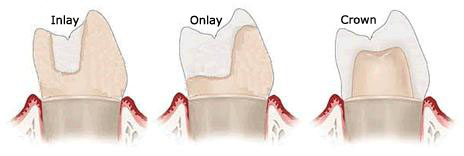Dental Inlays & Onlays
Dental inlays and onlays are a dental procedure that is used to restore a decayed or damaged tooth to its original condition and can actually strengthen it. They are a more conservative approach than a dental crown because they don't involve the removal of healthy tooth structure. For this reason inlays and onlays are considered a minimally invasive cosmetic dentistry treatment and for many dentists and patients is a much better choice. A crown, although not a bad procedure, involves the removal of more healthy tooth structure than needed and can increase the risk of tooth fracture and the need for a root canal treatment.

They can be a very good solution for fixing a tooth when its damage does not allow restoration with a simple filling but the decay is not as spread to need a crown.
Inlays and onlays are fabricated in a dental lab and are then fitted and bonded to the damaged tooth by the dentist. This type of restoration is called an indirect filling because unlike a traditional dental filling they are not molded into place during your dental visit.
What is the Difference Between an Inlay & Onlay?
Both inlays and onlays are pre-formed in a lab before being bonded to the damaged or decayed tooth. The difference of use depends on the amount of tooth structure that has been lost to wear or decay.
An inlay fits within the grooves that are within the cusps of your teeth. An onlay, the larger of the two, fits within the grooves but wraps up and over the cusps covering more of the tooth's surface. An onlay is used when the damage is more extensive and the restoration covers the entire chewing surface including one or more tooth cusps.
One of the benefits of having an inlay or an onlay is the resistance over time and has better aesthetic results over amalgam fillings.



